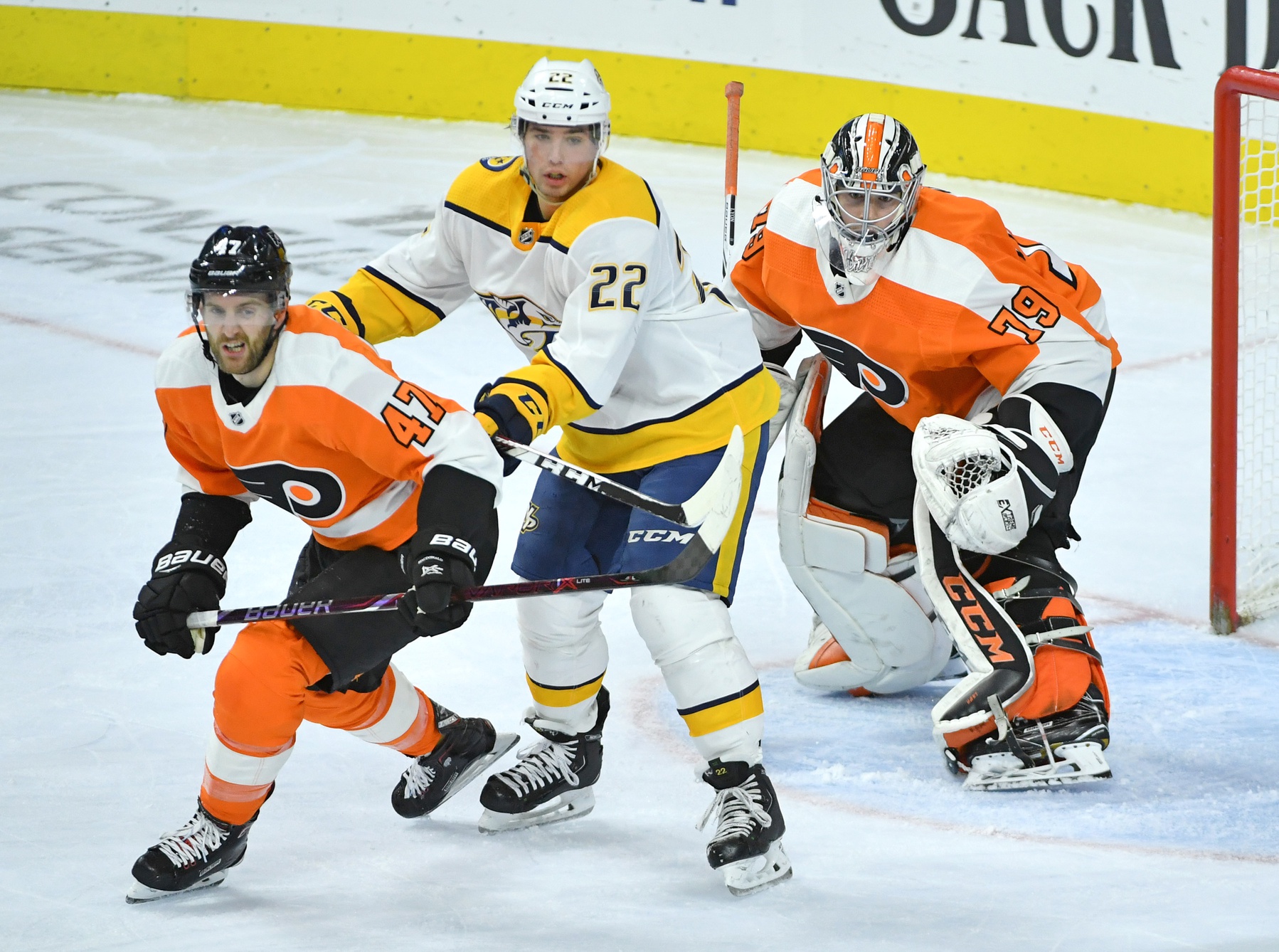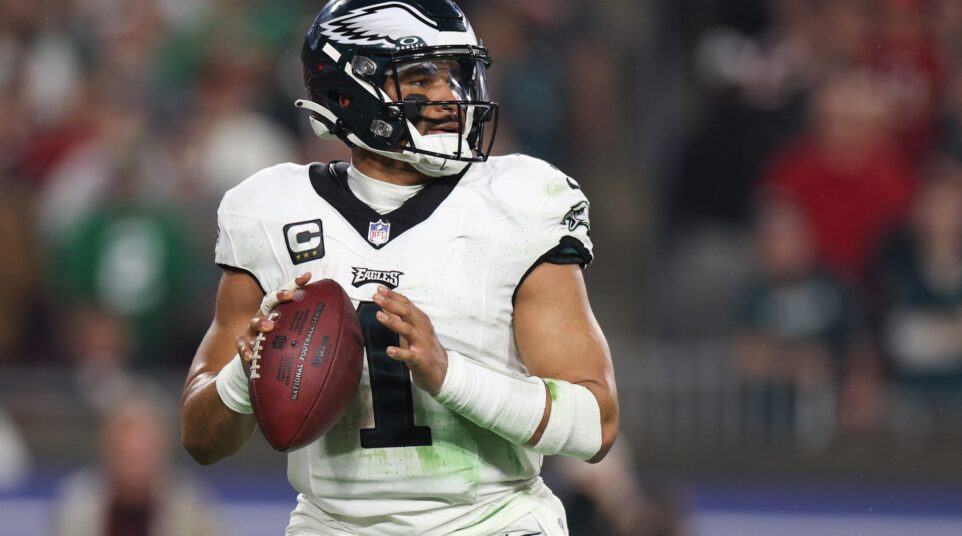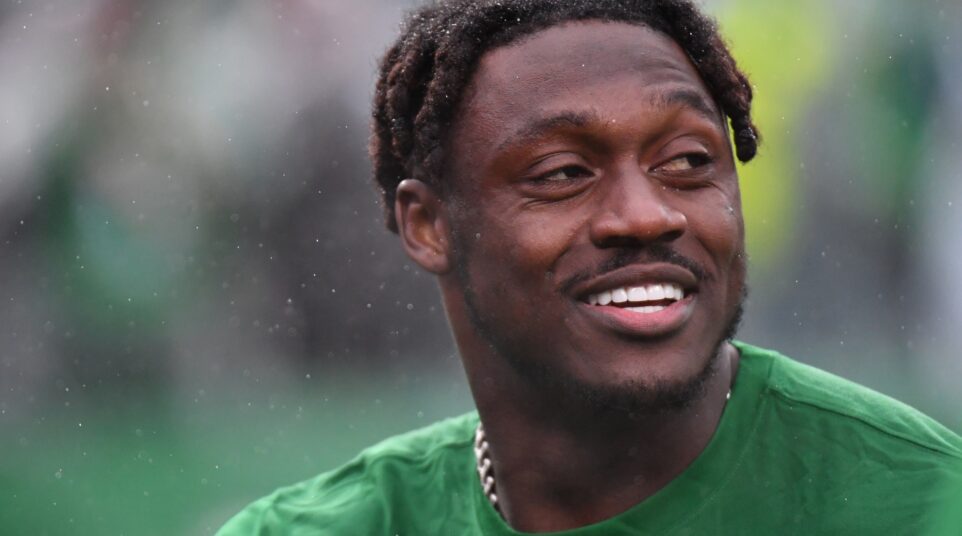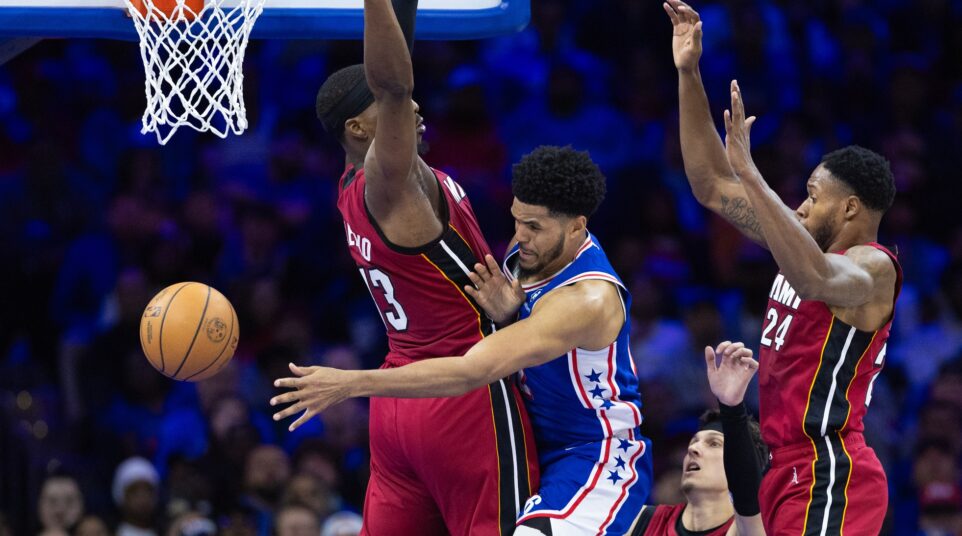
The Kill is Alive: Thoughts after Flyers 2, Predators 1
The phrase being tossed around this week is that the Flyers “are fun again.”
Two home wins following the firing of a coach who was publicly maligned for more than two years by the fans and starting the heir apparent, a 20-year-old rookie goalie, who the same fans have been screaming for will bring about that feeling.
And to be fair to the Flyers, they have played two solid games, most notably on the defensive side. Yes, Carter Hart has done a fine job in goal, but more so because he’s been able to make more routine saves that many other goalies the Flyers have trotted out this season.
No, instead of focusing on Hart, the real change has been the Flyers playing more soundly in their own end. They’ve improved their breakout. They haven’t alarmingly turned the puck over in the past two games like they did so often in the previous 30 games.
Winning both games helps, too, because it also energizes the fan base into thinking they were right all along and that the problem was the coach and the fact that Hart wasn’t on the team.
If you want to believe that, fine. Go nuts. It’s not accurate, even if it has played out that way for two games.
There are other factors, like Detroit, the team they beat Tuesday, being pretty terrible. And Nashville, the team the Flyers upset Thursday, playing without a couple key players.
But that’s the nature of the sport. Good teams take advantage of those breaks in their schedule and while it’s likely too soon to call the Flyers a good team, they certainly did take advantage of those breaks.
But there’s something else that is vastly improved about this hockey team, and it’s something that began well before Hart’s arrival and well before Dave Hakstol was fired, and it’s the No. 1 reason they were able to stave off the Predators on Thursday.
Find out what it is after the jump:
A suddenly stingy penalty kill
There was a time this season when the Flyers were on pace to be historically bad at killing penalties. Through the first 21 games, the Flyers penalty kill was only successful 68.5 percent of the time. It was a pace that, if maintained over the course of an entire season, would have resulted in the worst penalty kill percentage since the NHL started tracking that statistic in 1979-80.
Yeah, it was that bad.
But since then, which coincided with Thanksgiving, the Flyers have done a complete 180.
Yes, it’s a small sample size, but in the 12 games since, the Flyers penalty kill has allowed just five goals on 38 chances, killing off penalties at an 86.8 percent clip.
Consider that three of those goals allowed came in a 7-1 drubbing at the hands of Winnipeg, that means the Flyers have allowed a total of only three power play goals against in the other 11 games.
Assistant coach Ian Laperriere has been a target of the fans’ ire for much of the past two seasons because of the ineptitude of the penalty kill. It’s hard to say those outcries by the fans weren’t justified.
But just as he’s deservedly been the scapegoat for the penalty kill’s failings, he also needs to be recognized in a positive manner for finding a fix to this long-standing problem with the team – even if it’s only been a temporary one.
The Flyers killed off all six of Nashville’s power play chances Thursday. And while not having P.K. Subban manning the point or three of their top five goal scorers (Filip Forsberg, Colton Sissions, Viktor Arvidsson) in the lineup likely crippled Nashville some, the way the Flyers competed on the kill was still impressive.
“Our PK hasn’t been the best during the season, but I think during the last 10 games it has been a lot better,” said Robert Hagg. “I don’t know how many PKs we had, but every single guy that was on the ice did a hell of a good job.
“It’s all about the small details and I think we play with more pressure now than we did 10 games ago. We’re trying not to let them set up inside the zone, and I think that’s the biggest thing. … But you need to block shots, that’s what everybody in this room is saying, we need to keep doing that to be successful.”
As a whole, the Flyers blocked 23 in the game against the Predators. Hagg and Travis Sanheim led the way with five each, although 13 of the Flyers’ 18 skaters were credited with at least one block.
But never were they more important than on a two-minute, two-man shorthanded situation.
Late in the second period, the Flyers took three successive penalties. Wayne Simmonds wiped out the end of a power play with a chintzy hooking call. Radko Gudas was then whistled for delay of game which was immediately followed up by a high-sticking call on Andrew MacDonald that never made it above the top of the Predators logo on Kevin Fiala’s chest. However, Fiala sold it well, and the Flyers faced a daunting task.
With Ivan Provorov already off the ice with a misconduct (more on that in a bit) and Gudas and McDonald in the box, Coach Scott Gordon had little left in the way of options to kill off the two-minute penalty other than Sanheim and Hagg. Yeah, Shayne Gostisbehere was available, but he’s not reliable enough defensively to kill a penalty at 5-on-4, let alone 5-on-3, so it was the two second-year defenseman and Sean Couturier who coach Scott Gordon turned to and, well, they delivered:
(video courtesy of Charlie O’Connor at The Athletic)
Sanheim (21:58) and Hagg (20:59) were the top two minutes guys among the Flyers defensemen and they combined for more than 10 minutes of ice time while shorthanded.
Couturier also shows why he is an elite defensive forward on this kill. And it energized the building, as any good penalty kill in a one-goal game can – but when you are doing it two-men down for two minutes… that’s something else entirely.
Speaking of Sanheim
He’s arguably the Flyers best defenseman right now. Again, I know there are fans who have been screaming this for two years – that he should play more, that Hakstol stunted his growth, yada, yada, yada. But the fact is, he needed to be put on this path. He needed to develop with a little more nurturing. He needed to build confidence a little more slowly than some other players. That’s all O.K.
And if you think it was Hakstol who was stunting him, you’re fooling yourself. I asked Scott Gordon about Sanheim’s development, and this is what he had to say:
“In Travis’ first three months in Lehigh (in 2016-17) he was keeping both teams in it, that was his biggest adjustment. By December he was a little more responsible defensively and picking his spots better to jump up into the play.
“He plays that first year and no matter how much you learn and get better in the American League, there’s always going to be another adjustment in the NHL. Players are bigger, stronger, faster and decisions have to be made quicker. You can’t replicate that in the American League.
“So, he had some growing pains last year. But this year, you started to see him score a couple goals. He’s getting up into the play more. That’s a strength of his. Somewhere along the way on this most recent road trip (Assistant Coach Rick Wilson) started mixing up the D pairs and wanted to try some different things. When I got here, his recommendation was to play Sanheim with Provy.
“Obviously if you play with Provy you are going to get more ice time, and when you are a big body like that you’re going get some ice time on the penalty kill. And your minutes are going to go up, and, now he’s getting time against the other team’s top lines.
“With all that being said, he’s got to do the right things to deserve that opportunity and he has. Some of it is simplification. There was one play in the third period on the far side where he didn’t have anything and he threw it off the glass and he lives to play another day. He lives to play another shift. You know what I mean?
“Sometimes, when you are a young player you always think you can make a play and that was just one instance of his maturity as a player, recognizing the situation and identifying the fact that ‘I don’t have anything,’ get it out in the neutral zone, let a forecheck happen. Get in my gap and defend. That’s something the best defensemen do – they don’t beat themselves.”
There’s a lot to unpack here.
- I love the way Gordon gives you a detailed, thoughtful answer. This is bountiful with information and really gives you honest perspective.
- Speaking of which, I love the quip that Sanheim’s problem was he would “keep both teams in the game.” In other words, he was superior offensively but he often made bad decisions that would cost his team, and he needed to learn not to do that.
- He identified that getting going offensively is what Sanheim needed this year to really spike his confidence.
- That working with Rick Wilson is already paying dividends for Sanheim.
- That Gordon, ever the teacher, identified an innocuous clearing play in the third period as a seminal moment for Sanheim’s development. Never mind that the guy, who rarely plays on the penalty kill, helped author a textbook kill of a two-minute, two-man disadvantage, the clearing play off the glass rather than risking a turnover is what was most impressive.
- Overall, that Sanheim is earning his promotion to the top pairing and his bigger minutes.
- And yet, that this is a shining example of a good, patient process for a young player playing out before our eyes.
I also had an opportunity to talk to Sanheim one-on-one after the game. Here’s how that went:
Q: You haven’t been asked to play a lot of PK this season, and then tonight, you were called into duty. Can you talk about jumping into that role and then being out there for the entire 5-on-3?
“Last year when I was sent down to the American League (Gordon) would leave me out on the penalty kill for the entire two minutes. So, I’m familiar with the situation and being able to kill penalties. It was something different for me this season, yes, but it wasn’t just me out there. Hagg and Coots deserve full credit, too.”
Q: You had to know with three defensemen in the box and with Ghost not playing on the kill that you guys were probably going to have to play the full two minutes, right?
“It’s not something that I was really thinking about to tell the truth. It was just that ‘next man up’ mentality, really. I just wanted to step up to the challenge. Hagg did, too. He had three or four blocks on that one kill alone. Credit to him for doing that. It made it easy for me.”
Q: Good that you were able to get a breather in there when Scott called the timeout too?
“He came down the bench to talk to us and see how we were feeling. He asked us if we thought he should take the timeout. I said that if he was willing to use it there that it would be a good time. It was nice to get the rest there for 30 seconds and then be able to go right back out there.”
Q: It’s no secret that confidence is a big thing for you and that you’ve been playing with a lot of it lately. Does being able to help the team win in this way – through defensive posture more so than your offensive ability – just add to that growing confidence?
“Yeah, I think so. Anytime you get to play in all situations you feel like you are contributing more to the team. That said, it doesn’t matter how many minutes I’m playing, I’m there to help the team win hockey games, but in the end, I’m going to do everything I can for however many minutes I play to do just that.”
Now, while the penalty kill was the key thing to focus on in this win, and I spent an inordinate number of words writing about it, there are some other things that I have to touch on before getting out of here, so:
MISCELLANEOUS STUFF
- Provorov is damn lucky:
Why Provorov got a 10-minute misconduct. pic.twitter.com/5pF8QBypIP
— Broad Street Hockey (@BroadStHockey) December 21, 2018
This kind of action usually results in a match penalty and a game misconduct. In that instance, there is an automatic 10-game suspension. No hearing. No negotiation. 10 games. Out. But, by getting only a 10-minute misconduct, he will likely avoid that significant suspension. I expect a fine of some sort… but that’s it. Big break for Provy and the Flyers.
- The non-call on Sean Couturier
I took abuse from Twitter for saying I agree with the referee in not calling this a penalty. I will say that I wouldn’t have been shocked if it was called a penalty, but this is far closer to a borderline call/non-call than it is a blatant and egregious boarding:
It looks worse at full speed and from the wide angle than it really is. The angle to pay attention to is the one from behind the net. The referee isn’t wrong that Couturier turned away from the check and that he does reach out to brace himself on the hit. Usually, those two things prevent a boarding call unless the skater takes several strides to hit a player from behind with force, which Ryan Johansson does not do in this instance.
I talked to Coots privately after the game, and while I won’t quote him specifically because I didn’t have my recorder on at the time, here are some things that he said:
- He’s fine. He doesn’t have a concussion. However, he was mad that he had to go to the quiet room to get checked for a concussion on a play that there was no penalty. If an off ice official was concerned for his health on a hit, then maybe the hit wasn’t good.
- He admitted he turned into the boards, but said he did so to protect the puck.
- He didn’t feel it was a major penalty, but thought it should have been a minor for two reasons. The first being that Johansson was not right on him, but took a stride before making contact. The second being they had just called a penalty on the Flyers for a high hit (Scott Laughton) and an earlier high stick on Andrew MacDonald (which wasn’t a high stick) was the result of Kevin Fiala throwing his head back. His thought process was if those were penalties than this should have been too.
I get the argument. And like I said, I wouldn’t have been screaming about an injustice for Nashville if the penalty was called. But, by the book – and not that the book is always right – this was a 50/50 judgment call and the ref went with the judgment that it wasn’t a penalty. I can’t disagree with that rationale.





